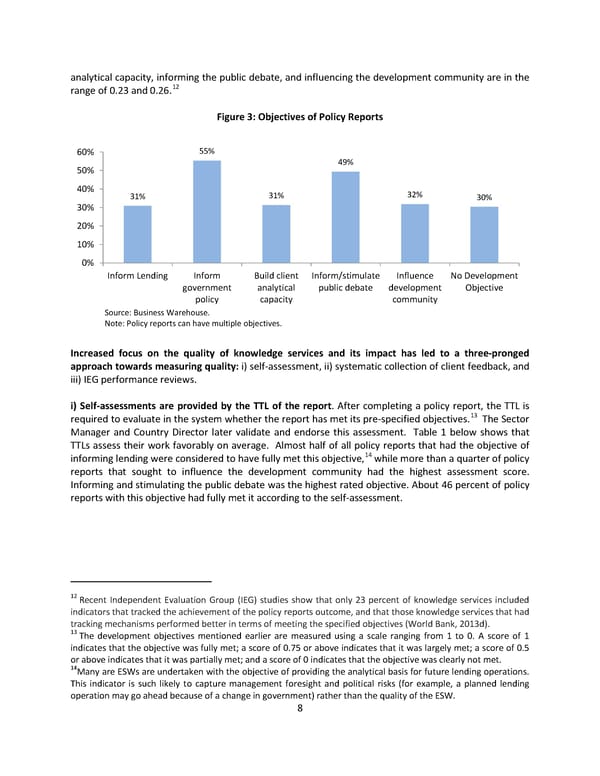analytical capacity, informing the public debate, and influencing the development community are in the range of 0.23 and 0.26.12 Figure 3: Objectives of Policy Reports 60% 55% 50% 49% 40% 31% 31% 32% 30% 30% 20% 10% 0% Inform Lending Inform Build client Inform/stimulate Influence No Development government analytical public debate development Objective policy capacity community Source: Business Warehouse. Note: Policy reports can have multiple objectives. Increased focus on the quality of knowledge services and its impact has led to a three-pronged approach towards measuring quality: i) self-assessment, ii) systematic collection of client feedback, and iii) IEG performance reviews. i) Self-assessments are provided by the TTL of the report. After completing a policy report, the TTL is required to evaluate in the system whether the report has met its pre-specified objectives.13 The Sector Manager and Country Director later validate and endorse this assessment. Table 1 below shows that TTLs assess their work favorably on average. Almost half of all policy reports that had the objective of informing lending were considered to have fully met this objective,14 while more than a quarter of policy reports that sought to influence the development community had the highest assessment score. Informing and stimulating the public debate was the highest rated objective. About 46 percent of policy reports with this objective had fully met it according to the self-assessment. 12 Recent Independent Evaluation Group (IEG) studies show that only 23 percent of knowledge services included indicators that tracked the achievement of the policy reports outcome, and that those knowledge services that had tracking mechanisms performed better in terms of meeting the specified objectives (World Bank, 2013d). 13 The development objectives mentioned earlier are measured using a scale ranging from 1 to 0. A score of 1 indicates that the objective was fully met; a score of 0.75 or above indicates that it was largely met; a score of 0.5 or above indicates that it was partially met; and a score of 0 indicates that the objective was clearly not met. 14Many are ESWs are undertaken with the objective of providing the analytical basis for future lending operations. This indicator is such likely to capture management foresight and political risks (for example, a planned lending operation may go ahead because of a change in government) rather than the quality of the ESW. 8
 Which World Bank Reports Are Widely Read? Page 13 Page 15
Which World Bank Reports Are Widely Read? Page 13 Page 15